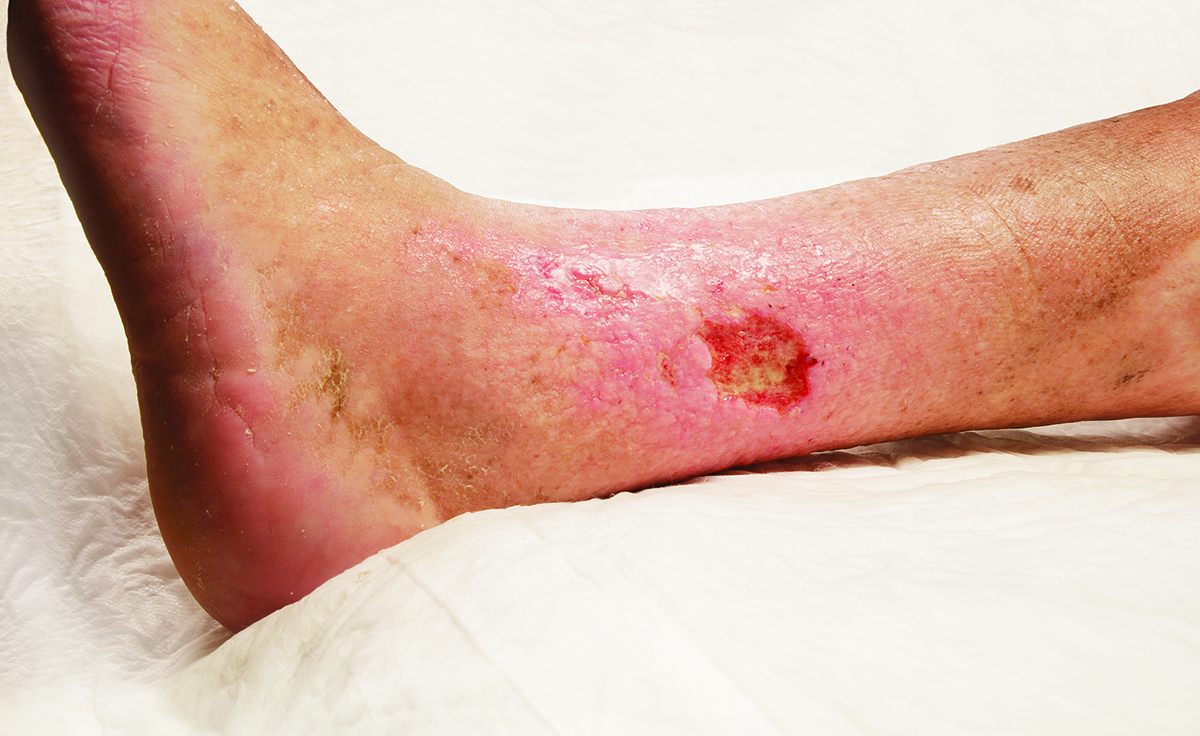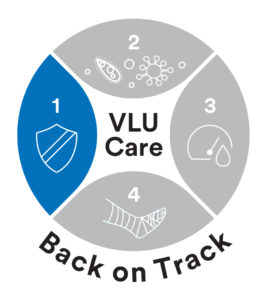
 Helping a patient to heal a venous leg ulcer (VLU) is a clinical challenge that can take anywhere from weeks to months. Maintaining skin integrity throughout the healing process can be an especially daunting task. While compression and exudate management are critical elements of care, the wound edge and surrounding skin should not be overlooked.
Helping a patient to heal a venous leg ulcer (VLU) is a clinical challenge that can take anywhere from weeks to months. Maintaining skin integrity throughout the healing process can be an especially daunting task. While compression and exudate management are critical elements of care, the wound edge and surrounding skin should not be overlooked.
Why care about the edge? Wound exudate – and venous ulcers are known for producing LOTS of exudate – creates a super-wet environment that causes changes to the epidermis; skin loses its natural, protective hardness and barrier function. Eventually, maceration can result. This is especially true when weekly compression wraps and dressing changes are the norm. When severe, maceration can lead to epidermal loss, essentially increasing the size and complexity of the wound. Exudate also contains high levels of proteases and bacterial byproducts which create inflammation and can contribute to skin injury.
Protecting skin
You may be thinking, ok, makes sense. We stock an ointment; I’ll apply that. While commonly used, traditional moisture barrier ointments (and even some barrier creams) have some limitations:
- They are occlusive, which means they don’t allow moisture (i.e., perspiration, exudate) to evaporate. This can exacerbate the problem, trapping moisture on intact, but vulnerable skin.
- They can contain multi-ingredient formulations potentially increasing the risk of sensitization. This is especially important for patients with VLUs due to their increased risk of allergy to topically applied products1
- Many are opaque, preventing visualization of the underlying skin and requiring removal during dressing changes. This can be uncomfortable for patients, and time consuming for you.
In contrast, polymer-based film-forming barriers can help protect the wound edge and surrounding skin from exudate 2-4 while allowing for observation of the skin and without requiring removal. Instead, they wear off over time with natural cell turnover and cleansing.
Adhesive considerations
Beyond maceration, periwound skin condition may be complicated by adhesive products. The risk of Medical Adhesive-Related Skin Injury (MARSI) increases with inappropriate adhesive selection, application or removal. Barrier films can act as a protective interface between the skin and adhesive products. During removal, the film lifts from the epidermis, sparing skin cells and helping to prevent painful stripping injuries. Other interventions that are essential to avoid MARSI include proper skin preparation, application without tension and careful adhesive product removal. Because of the vulnerability of skin in patients with VLUs, non-adhesive products (or those with a silicone adhesive coating) should always be considered.
Taking care of damaged skin
A different approach is needed when the wound edge is already macerated, or the surrounding skin is damaged. A cyanoacrylate-based elastomeric skin protectant can protect skin and create an environment for healing. The cyanoacrylate component enables attachment to, and protection of, moist, damaged surfaces; early data5 has shown positive results when used to manage maceration.
For many patients with VLUs, years of abnormal venous and lymphatic flow can lead to structural changes of the tissue. This includes epidermal, dermal and soft-tissue thickening. Hyperkeratosis (buildup of dry, flaky skin) and stasis dermatitis (inflammation of the epidermis and dermis) are common.
Whenever dermatitis is present in surrounding skin, this possibility of secondary infections should be considered. In Foroozan’s research,6 fungal species were present in 27.6% of the skin samples from venous ulcers. If infection is confirmed, the patient may benefit from a topical antimicrobial. Dermatitis without infection may benefit from a course of topical corticosteroids. 7
As edema resolves, dryness and flaking (desquamation) can be a problem. Daily application of a fragrance-free non-sensitizing moisturizer is the best choice for this topical-sensitive population.
Thinking “beyond the wound” involves building routine assessment and care of the skin into your daily practice. Interventions to protect and preserve the wound edge and surrounding skin may not only help with healing, but also improve the patient’s experience.
References:
1 Machet L et al. Sensitization to Topical Treatments used in Leg Ulcers: A Meta-analysis(1975-2003) Poster presentation. World Union of Wound Healing Societies. (WUWHS). 2008
2 Coutts P, Queen D, Sibbald RG. Peri-wound skin protection: a comparison of a new skin barrier vs. traditional therapies in wound management. Wound Care Canada. 2003;1(1).
3 Cameron J, Hoffman D, Wilson J, Cherry GJ. Comparison of two peri-wound skin protectants in venous leg ulcers. Wound Care. 2005;14(5):233-6.25)
4 Serra, N., et al. Effectiveness of the association of multilayer compression therapy and periwound protection with Cavilon® (no sting barrier film) in the treatment of venous leg ulcers. Gerokomos. 2010; 21(3):124-130.
5 LaForet K, Dias J, Muhammad S. Case series using an advanced silicone-based polymer skin protectant for the clinical management of patients with moisture-associated skin damage. (MASD). Canadian Association of Wound Care (CAWC); 2017.
6 Foroozan M et al. Prevalence Analysis of Fungi in Chronic Lower Extremity Ulcers. 2011;23(3):68-75
7 Rzepecki AK, Blaziak R. Stasis dermatitis: Differentiation from other common causes of lower extremity inflammation and management strategies. Current Geriatrics Reports. 2018; 7(1): 222-227.
